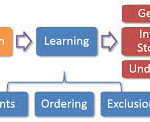 In his book “Teaming: How organizations learn, innovate, and compete in the knowledge economy”, Edmondson identifies scoping, structuring and sorting as the critical steps necessary to create successful teams.
In his book “Teaming: How organizations learn, innovate, and compete in the knowledge economy”, Edmondson identifies scoping, structuring and sorting as the critical steps necessary to create successful teams.
The first step in any teaming scenario is scoping out the challenge, determining, what expertise is needed, tapping collaborators, and outlining roles and responsibilities.
 The second critical step essential to creating successful teams is structuring. The idea is to offer some structure to help the team function effectively. Structuring also helps the group by establishing boundaries and targets. Thus, the objective of structuring is to make it easier for teaming partners to effectively coordinate and communicate.
The second critical step essential to creating successful teams is structuring. The idea is to offer some structure to help the team function effectively. Structuring also helps the group by establishing boundaries and targets. Thus, the objective of structuring is to make it easier for teaming partners to effectively coordinate and communicate.
Sorting is the third critical step necessary to create successful teams. Sorting is  the conscious prioritizing of tasks based on the degree of interdependence among individuals. Hence, the strategic focus of teaming in this regard is to ensure that people get comfortable with a new way of working rather than with a new set of colleagues. He argues that leaders have at their disposal four tools, namely, emphasizing purpose, building psychological safety, embracing failure, and putting conflict to work.
the conscious prioritizing of tasks based on the degree of interdependence among individuals. Hence, the strategic focus of teaming in this regard is to ensure that people get comfortable with a new way of working rather than with a new set of colleagues. He argues that leaders have at their disposal four tools, namely, emphasizing purpose, building psychological safety, embracing failure, and putting conflict to work.
 In essence, a purpose is fundamentally about shared values. Hence, the emphasis is on the common goal and vision, which can ultimately galvanize even the most diverse, amorphous team.
In essence, a purpose is fundamentally about shared values. Hence, the emphasis is on the common goal and vision, which can ultimately galvanize even the most diverse, amorphous team.